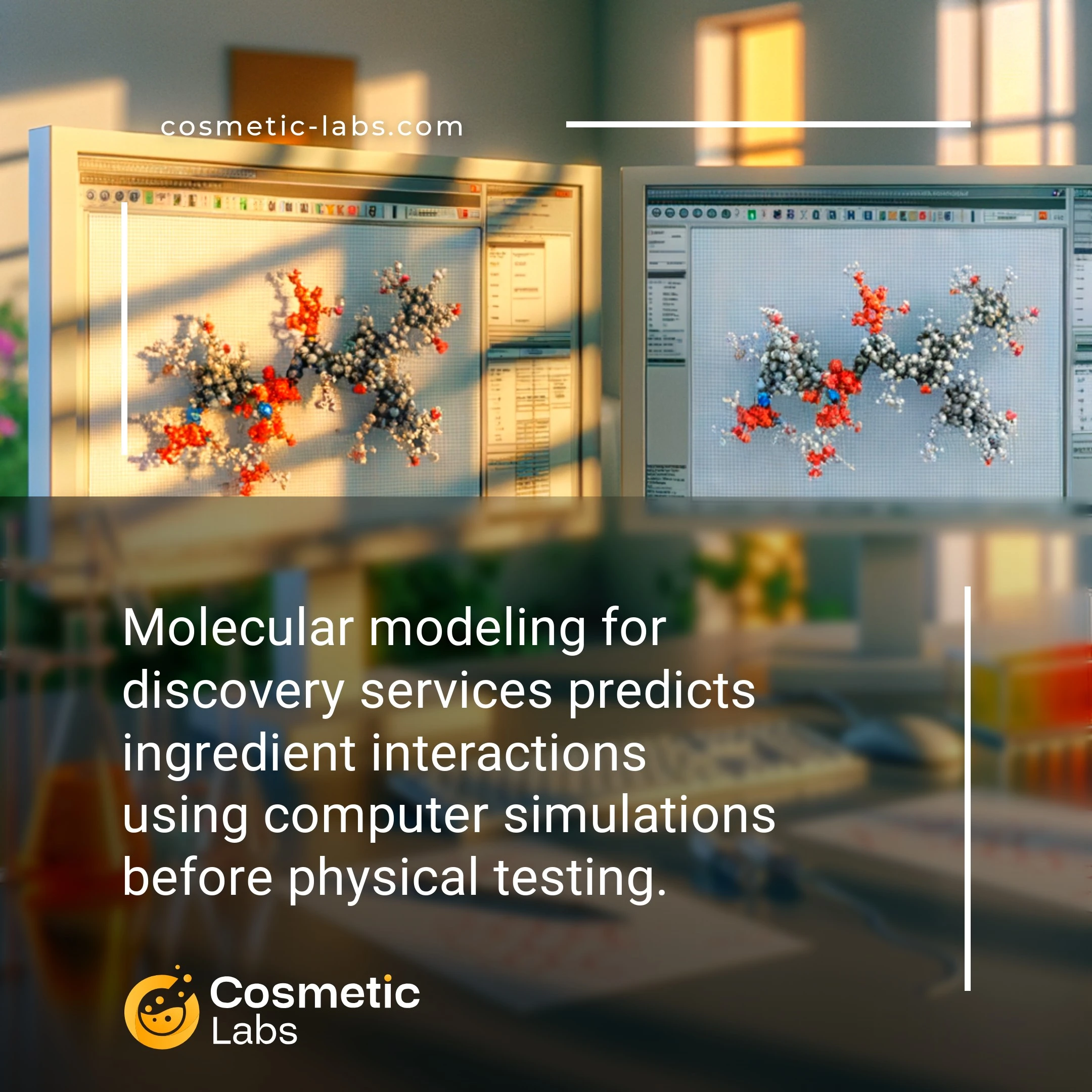Molecular Modeling Services for Cosmetic Discovery

What is Molecular modeling?
Molecular modeling for discovery services uses computer simulations to predict how cosmetic ingredients interact with skin proteins and cellular structures before physical testing begins. Labs on our platform employ quantum mechanics calculations and molecular dynamics to screen thousands of potential compounds, identifying which actives will penetrate skin barriers most effectively. This virtual screening approach reduces formulation costs by 40-60% while accelerating ingredient discovery timelines from months to weeks.
Why do you need this service?
Cosmetic labs use molecular modeling to predict ingredient interactions before physical testing, helping brands identify promising formulations within weeks instead of months. Teams screen thousands of potential active compounds virtually, testing their binding affinity to skin proteins and predicting penetration depths through digital skin models. This approach reduces R&D costs by 40-60% while accelerating time-to-market for anti-aging serums, sunscreens, and targeted treatments.
Who provides Molecular modeling services?
All cosmetic labs providing Molecular modeling services
There is no company providing these services at the moment.
Molecular Modeling for Discovery Services
Molecular modeling services help cosmetic brands predict ingredient behavior and interactions before physical testing begins. Labs use computational chemistry tools to simulate how active compounds will perform in formulations, reducing development time and costs.
Predictive Ingredient Analysis
Labs run molecular simulations to predict skin penetration rates, stability profiles, and potential interactions between ingredients. This computational screening identifies promising compounds early in development.
Key modeling capabilities include:
- Skin permeation modeling for active delivery
- Molecular docking studies for receptor binding
- Stability prediction under various pH conditions
- Solubility forecasting in different carrier systems
These simulations help you select the most viable ingredients before investing in physical prototypes.
Structure-Activity Relationship Studies
Labs analyze how molecular structure affects cosmetic performance through QSAR modeling. This approach predicts which structural modifications will improve efficacy, safety, or stability.
Common applications include:
- Optimizing peptide sequences for anti-aging effects
- Designing surfactants with specific cleansing properties
- Modifying preservatives to reduce irritation potential
Connect with specialized labs on our platform to access molecular modeling expertise that accelerates your ingredient discovery process.
Practical Applications of Molecular Modeling for Discovery Services
Cosmetic labs use molecular modeling for discovery services to predict ingredient interactions, optimize formulations, and reduce development timelines from months to weeks.
Active Ingredient Compatibility Screening
Labs run molecular dynamics simulations to predict how new actives interact with existing formula components before physical testing. This approach identifies potential stability issues, pH conflicts, or chemical incompatibilities that could cause product failure.
QSAR (Quantitative Structure-Activity Relationship) models help predict skin penetration rates and bioavailability of peptides, retinoids, and botanical extracts. Teams can screen 50-100 ingredient combinations digitally in 2-3 days versus 6-8 weeks of lab testing.
Delivery System Optimization
Molecular modeling guides the design of liposome encapsulation systems and nanoparticle carriers for targeted ingredient delivery. Labs simulate how different lipid compositions affect membrane stability and release kinetics.
Computational models predict optimal particle sizes for different skin types and application methods. This data drives formulation decisions for serums, creams, and treatment products before prototype development begins.
| Modeling Application | Time Savings | Cost Reduction | Primary Benefit |
|---|---|---|---|
| Ingredient Compatibility | 4-6 weeks | 60-70% | Prevents formulation failures |
| Penetration Prediction | 2-3 weeks | 40-50% | Optimizes active delivery |
| Stability Forecasting | 8-12 weeks | 70-80% | Reduces shelf-life testing |
| Sensory Modeling | 3-4 weeks | 50-60% | Improves texture prediction |
Ready to accelerate your product development with molecular modeling services? Connect with specialized cosmetic labs on our platform to discuss your specific formulation challenges and discovery timelines.
